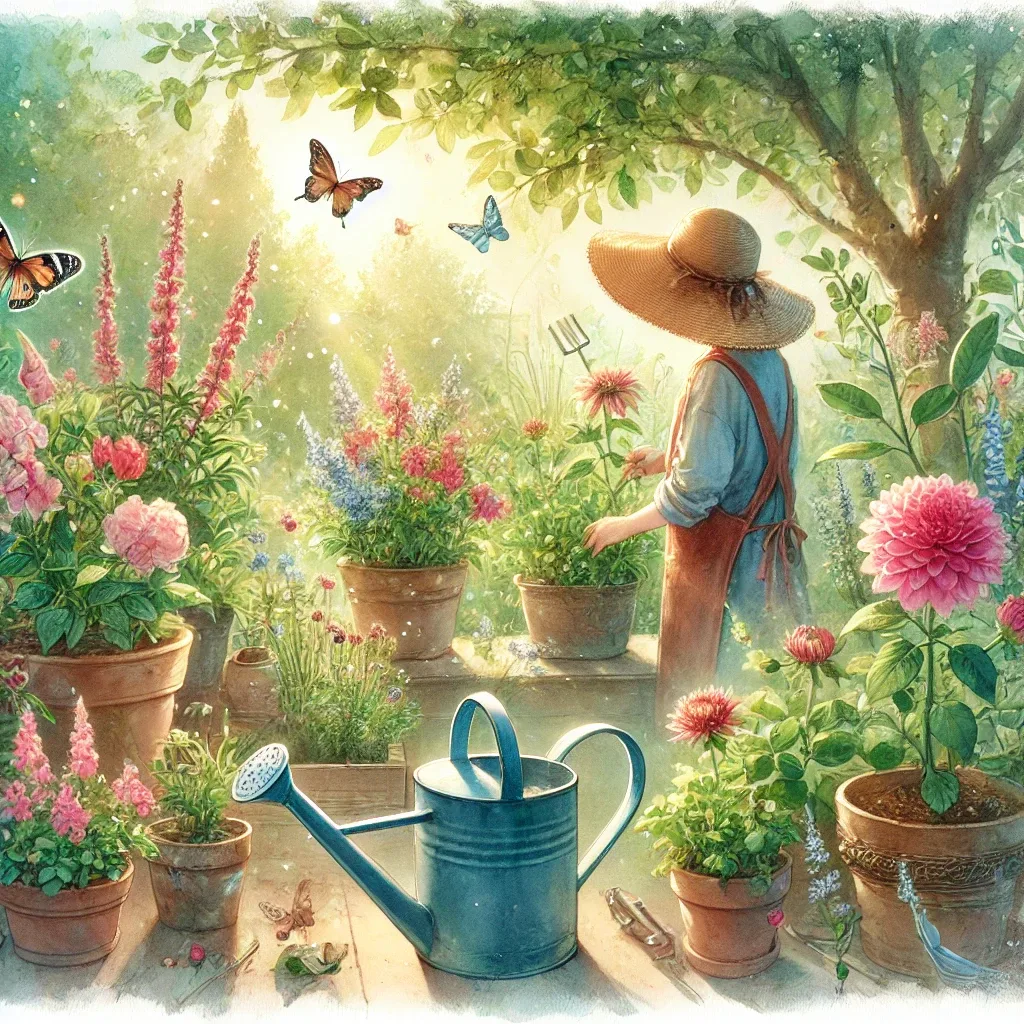Introduction
Gardening is a rewarding and fulfilling activity that brings numerous benefits to beginners. It provides fresh, homegrown produce, enhances mental well-being, and offers a great way to connect with nature. Whether you have a large backyard or just a small balcony, starting a garden can be a fun and enriching experience for gardening for beginners.
However, many beginners hesitate to start due to concerns about space, the effort required, or a lack of gardening knowledge. Questions like “Where should I plant?” or “What if my plants don’t grow?” often discourage people from taking the first step. The good news is that gardening doesn’t have to be complicated—with the right approach, anyone can create a thriving garden.
This guide will walk you through the essential steps to start a successful garden, from choosing the right location to maintaining healthy plants. By the end, you’ll have the confidence and knowledge to grow your own beautiful and productive garden.
Choosing the Right Location
Selecting the right location is crucial for a successful garden. A well-chosen spot ensures healthy plant growth and makes maintenance easier. Here are the key factors to consider:
Sunlight
Most plants, especially vegetables and flowers, require at least 6-8 hours of direct sunlight each day. Observe your space throughout the day to determine which areas receive the most sunlight. Avoid heavily shaded spots, as plants may struggle to grow without sufficient light.
Accessibility
Your garden should be easy to reach for regular watering, weeding, and harvesting. If it’s too far or inconveniently located, maintaining it can become a hassle. Choose a spot that allows you to check on your plants frequently and comfortably.
Water Source
Plants need consistent watering, especially in dry seasons. Ensure your garden is close to a water source to make watering easier. If your chosen spot is far from a tap, consider installing a hose or setting up a rainwater collection system to keep your plants hydrated efficiently.
Planning Your Garden
Before planting, it’s essential to plan your garden properly. This includes deciding what to grow and determining the right garden size.

What to Grow
As a beginner, start with easy-to-grow vegetables, herbs, or flowers that require minimal care. Some great options include:
- Vegetables: Tomatoes, peppers, lettuce, radishes, and carrots.
- Herbs: Basil, mint, parsley, and chives.
- Flowers: Marigolds, zinnias, and sunflowers.
If space is limited, opt for compact or vertical-growing plants
like cherry tomatoes, green onions, or climbing beans. Avoid large, sprawling plants like pumpkins unless you have enough room.
Garden Size
Starting small is key to avoiding overwhelm. A 10’x10’ plot or a few raised garden beds is a manageable size for beginners. This allows you to focus on learning and maintaining your plants without feeling stressed. As you gain experience, you can gradually expand your garden based on what works best for you.

Preparing the Soil
Healthy soil is the foundation of a thriving garden. Before planting, it’s essential to prepare the soil to ensure your plants receive the nutrients they need.
Soil Testing
Testing your soil helps determine its pH level and nutrient content. Most vegetables and flowers grow best in slightly acidic to neutral soil (pH 6.0–7.0). A soil test kit or a professional soil test from a local extension service can reveal what your soil lacks, allowing you to make the necessary adjustments.
Soil Amendments
Once you know your soil’s condition, enrich it by adding organic matter such as:
- Compost: Improves soil structure, enhances drainage, and provides essential nutrients.
- Aged Manure: Adds organic material and boosts fertility.
- Mulch: Helps retain moisture and prevent weeds.
- Perlite or Sand: Improves drainage in heavy clay soils.
Mix these amendments into the top 6-12 inches of soil to create a nutrient-rich growing environment.
Selecting and Planting
Choosing the right plants and planting them correctly ensures a successful garden.
Seeds vs. Transplants
Beginners can start their garden in two ways:
- Seeds: Ideal for fast-growing plants like radishes, carrots, and lettuce. Seeds are more affordable but require patience and consistent care.
- Transplants (Seedlings): Great for beginners as they provide a head start. Buying young plants from a nursery makes growing vegetables like tomatoes and peppers easier.
For ease, new gardeners should begin with nursery transplants for long-season crops and direct sow seeds for quick-growing vegetables.
Companion Planting
Certain plants grow better when placed together. Companion planting improves growth, deters pests, and maximizes space. Some great plant pairings include:
- Tomatoes + Basil: Basil enhances tomato flavor and repels insects.
- Carrots + Onions: Onions deter carrot flies.
- Lettuce + Radishes: Radishes help loosen the soil for lettuce roots.
Avoid planting incompatible combinations, such as tomatoes and potatoes, which can spread diseases.
Planting Techniques
Proper planting ensures strong, healthy plants. Follow these key guidelines:
- Spacing & Depth: Avoid overcrowding by following the recommended spacing for each plant.
- Hardening Off: If starting with indoor seedlings, gradually acclimate them to outdoor conditions over a week before planting.
- Watering After Planting: Water thoroughly after planting to help roots establish.
Watering and Maintenance
Proper watering and regular maintenance are key to keeping a garden healthy and thriving.

Watering Schedule
Consistent watering helps plants develop strong root systems. Follow these best practices:
- Water deeply but infrequently: This encourages deep root growth, making plants more resilient to drought.
- Morning watering is best: This allows water to soak into the soil before the sun evaporates it.
- Avoid overwatering: Too much water can lead to root rot and fungal diseases. Check soil moisture by inserting your finger about an inch deep—if it’s dry, it’s time to water.
Mulching
Mulch is a gardener’s best friend. It helps with:
- Retaining moisture, reducing the need for frequent watering.
- Suppressing weeds, preventing competition for nutrients.
- Regulating soil temperature, keeping roots cool in summer and warm in winter.
Use organic mulches like wood chips, straw, or grass clippings for added nutrients.

Pest and Disease Monitoring
A healthy garden requires vigilance. Keep an eye out for:
- Common pests: Aphids, caterpillars, and slugs can damage plants. Use natural solutions like neem oil or introduce beneficial insects (e.g., ladybugs) to control them.
- Disease signs: Yellowing leaves, mold, or stunted growth may indicate fungal or bacterial issues. Remove infected plants early to prevent spreading.
Learning and Adapting
Gardening is a continuous learning process. The more you observe and experiment, the better your results.

Observing Plant Health
Take time to inspect plants daily. Note changes in growth, leaf color, or any signs of stress. Adjust watering, fertilization, or sunlight exposure as needed.
Keeping a Gardening Journal
A gardening journal helps track progress and improve future seasons. Record details like:
- Planting dates
- Watering and fertilizing schedules
- Pest issues and solutions
- What worked well and what didn’t
These notes will help refine your gardening techniques over time.
Conclusion
Gardening is a rewarding journey that brings joy, fresh produce, and a deeper connection to nature.
Enjoy the Process
Don’t stress about perfection—gardening is about learning and growing along with your plants. Mistakes will happen, but each one is an opportunity to improve.
Final Tips for Success
- Start small and expand as you gain confidence.
- Be patient—gardens take time to flourish.
- Stay curious—research new techniques and experiment with different plants.
FAQ’s
What is the easiest garden to start?
A small vegetable or herb garden in raised beds or containers is the easiest to start. Options like tomatoes, lettuce, basil, and mint grow well with minimal effort.
How do you plan home gardening?
Start by choosing a sunny location, deciding what to grow, testing and preparing the soil, and selecting easy-to-maintain plants. Begin with a small space and expand as you gain experience.
What is the most common mistake of first-time gardeners?
Overwatering and overcrowding plants are common mistakes. Stick to proper spacing and water only when the soil is dry an inch below the surface.
What is the first thing a gardener plants in the garden?
Hardy plants like lettuce, radishes, and peas are great first choices. They grow quickly and are easy to manage.
How do I choose the right plants for my garden?
Consider your climate, space, and experience level. Start with low-maintenance plants suited to your region, like tomatoes, peppers, or marigolds.
What tools do I need to start gardening?
Basic tools include a hand trowel, gardening gloves, watering can, pruning shears, and a hoe or rake for soil preparation.

